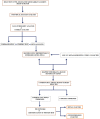RPL6: A Key Molecule Regulating Zinc- and Magnesium-Bound Metalloproteins of Parkinson's Disease
- PMID: 33790735
- PMCID: PMC8006920
- DOI: 10.3389/fnins.2021.631892
RPL6: A Key Molecule Regulating Zinc- and Magnesium-Bound Metalloproteins of Parkinson's Disease
Abstract
Parkinson's disease (PD) is a progressive neurodegenerative disease with no definite molecular markers for diagnosis. Metal exposure may alter cellular proteins that contribute to PD. Exploring the cross-talk between metal and its binding proteins in PD could reveal a new strategy for PD diagnosis. We performed a meta-analysis from different PD tissue microarray datasets to identify differentially expressed genes (DEGs) common to the blood and brain. Among common DEGs, we extracted 280 metalloprotein-encoding genes to construct protein networks describing the regulation of metalloproteins in the PD blood and brain. From the metalloprotein network, we identified three important functional hubs. Further analysis shows 60S ribosomal protein L6 (RPL6), a novel intermediary molecule connecting the three hubs of the metalloproteins network. Quantitative real-time PCR analysis showed that RPL6 was downregulated in PD peripheral blood mononuclear cell (PBMC) samples. Simultaneously, trace element analysis revealed altered serum zinc and magnesium concentrations in PD samples. The Pearson's correlation analysis shows that serum zinc and magnesium regulate the RPL6 gene expression in PBMC. Thus, metal-regulating RPL6 acts as an intermediary molecule connecting the three hubs that are functionally associated with PD. Overall our study explores the understanding of metal-mediated pathogenesis in PD, which provides a serum metal environment regulating the cellular gene expression that may light toward metal and gene expression-based biomarkers for PD diagnosis.
Keywords: Parkinson’s disease; gene expression; meta-analysis; metalloprotein network; serum metals.
Copyright © 2021 Anirudhan, Angulo-Bejarano, Paramasivam, Manokaran, Kamath, Murugesan, Sharma and Ahmed.
Conflict of interest statement
The authors declare that the research was conducted in the absence of any commercial or financial relationships that could be construed as a potential conflict of interest.
Figures






Similar articles
-
Interdependence of metals and its binding proteins in Parkinson's disease for diagnosis.NPJ Parkinsons Dis. 2021 Jan 4;7(1):3. doi: 10.1038/s41531-020-00146-7. NPJ Parkinsons Dis. 2021. PMID: 33398051 Free PMC article.
-
Integrated microarray analysis provided a new insight of the pathogenesis of Parkinson's disease.Neurosci Lett. 2018 Jan 1;662:51-58. doi: 10.1016/j.neulet.2017.09.051. Epub 2017 Sep 28. Neurosci Lett. 2018. PMID: 28965931
-
A meta-analysis of public microarray data identifies biological regulatory networks in Parkinson's disease.BMC Med Genomics. 2018 Apr 13;11(1):40. doi: 10.1186/s12920-018-0357-7. BMC Med Genomics. 2018. PMID: 29653596 Free PMC article.
-
Selenium and Other Trace Elements in the Etiology of Parkinson's Disease: A Systematic Review and Meta-Analysis of Case-Control Studies.Neuroepidemiology. 2020;54(1):1-23. doi: 10.1159/000502357. Epub 2019 Aug 27. Neuroepidemiology. 2020. PMID: 31454800
-
Implications of DNA Methylation in Parkinson's Disease.Front Mol Neurosci. 2017 Jul 18;10:225. doi: 10.3389/fnmol.2017.00225. eCollection 2017. Front Mol Neurosci. 2017. PMID: 28769760 Free PMC article. Review.
Cited by
-
Comparative analysis of phosphorylated proteomes between plerocercoid and adult Spirometra mansoni reveals phosphoproteomic profiles of the medical tapeworm.Parasit Vectors. 2024 Aug 31;17(1):371. doi: 10.1186/s13071-024-06454-8. Parasit Vectors. 2024. PMID: 39217359 Free PMC article.
-
Identifying COVID-19-Specific Transcriptomic Biomarkers with Machine Learning Methods.Biomed Res Int. 2021 Jul 6;2021:9939134. doi: 10.1155/2021/9939134. eCollection 2021. Biomed Res Int. 2021. Retraction in: Biomed Res Int. 2023 Nov 29;2023:9878305. doi: 10.1155/2023/9878305. PMID: 34307679 Free PMC article. Retracted.
-
Aging disrupts the coordination between mRNA and protein expression in mouse and human midbrain.bioRxiv [Preprint]. 2024 Jun 1:2024.06.01.596950. doi: 10.1101/2024.06.01.596950. bioRxiv. 2024. Update in: Mol Psychiatry. 2025 Jul;30(7):3039-3054. doi: 10.1038/s41380-025-02909-1. PMID: 38854057 Free PMC article. Updated. Preprint.
-
The Role of Magnesium in Parkinson's Disease: Status Quo and Implications for Future Research.Int J Mol Sci. 2024 Aug 1;25(15):8425. doi: 10.3390/ijms25158425. Int J Mol Sci. 2024. PMID: 39125993 Free PMC article. Review.
-
RNA-seq analysis of gene expression profiles in posttraumatic stress disorder, Parkinson's disease and schizophrenia identifies roles for common and distinct biological pathways.Discov Ment Health. 2022 Mar 3;2(1):6. doi: 10.1007/s44192-022-00009-y. Discov Ment Health. 2022. PMID: 37861850 Free PMC article.
References
-
- Bosco D., Plastino M., Cristiano D., Colica C., Ermio C., De Bartolo M., et al. (2012). Dementia is associated with insulin resistance in patients with Parkinson’s disease. J. Neurol. Sci. 315 39–43. - PubMed
LinkOut - more resources
Full Text Sources
Other Literature Sources

